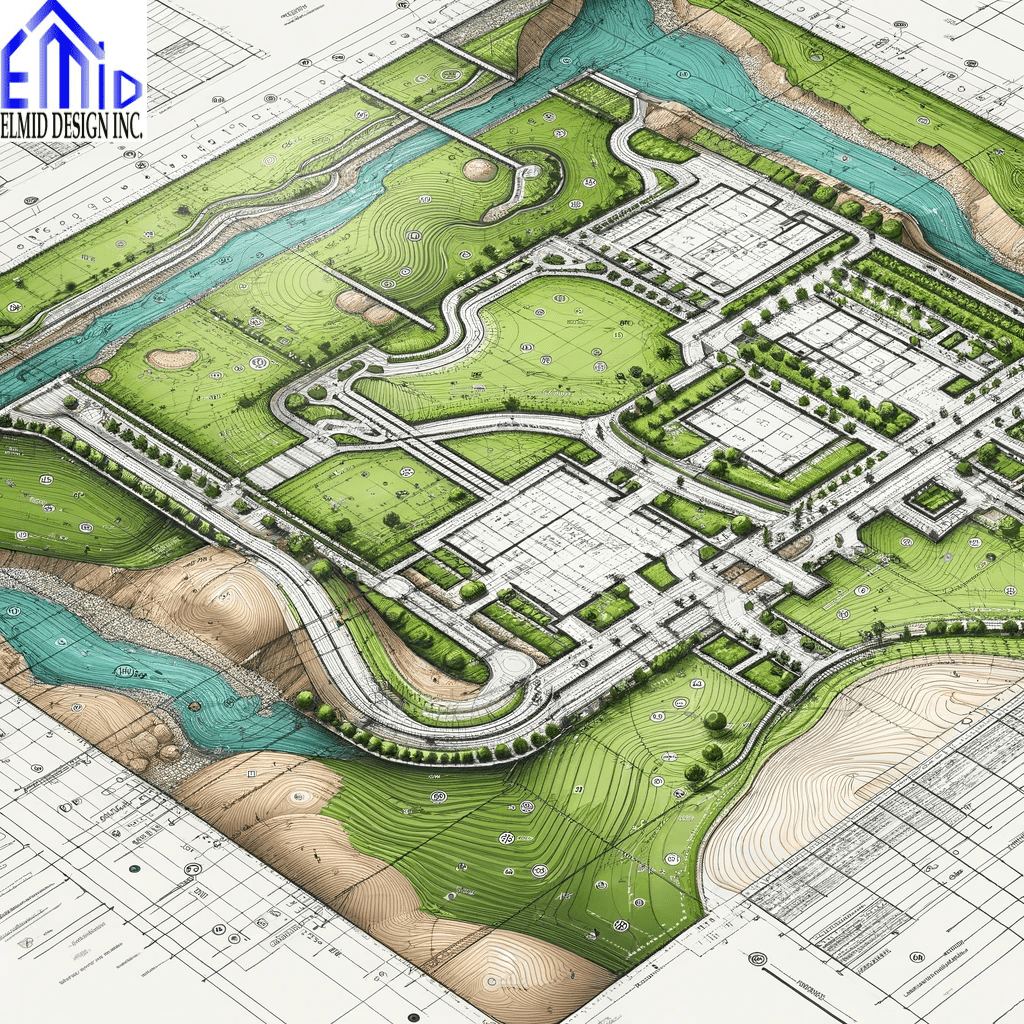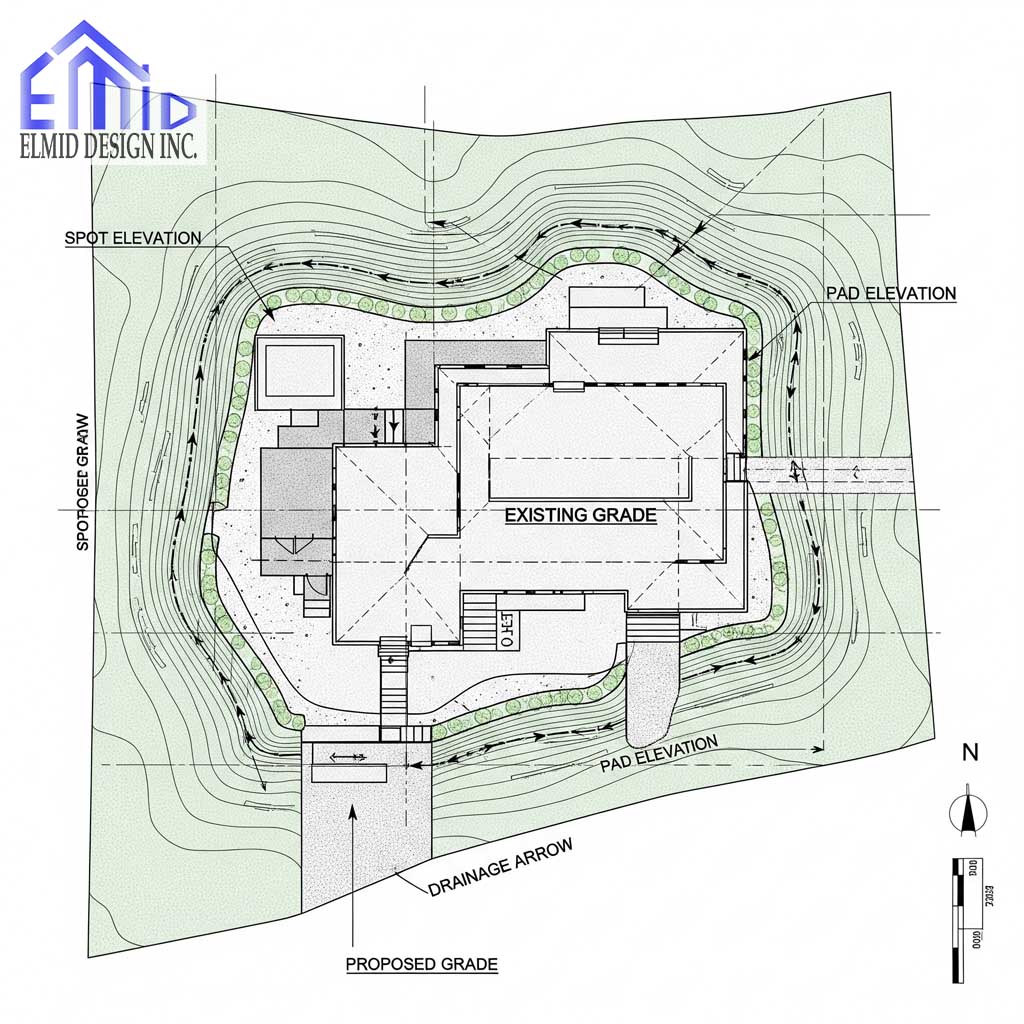A grading plan for building projects in Georgetown, Ontario outlines how the land around a site will be shaped to manage drainage, protect adjacent properties, and satisfy municipal regulations while ensuring structural stability and environmental safety.
What Is a Grading Plan in Georgetown
A grading plan shows proposed changes to land elevations and contours near a building site. It clarifies how stormwater will flow across the property, helps prevent water from pooling around structures, and maintains proper site drainage. Municipalities like Halton Hills require these plans to ensure compliance with land use and safety regulations. The plan typically includes existing and proposed grades, swales, flow directions, and low-impact design elements.
Why Grading Plans Matter for Site Safety
A precise grading plan plays a vital role in avoiding foundation damage, water infiltration, and erosion. It mitigates flood risks by directing runoff away from buildings and toward proper drainage paths. The plan helps protect neighbouring properties from negative impacts of surface water. It also supports stability across the site by preventing soil erosion. In urban areas like Georgetown, proper grading contributes to public safety and property longevity.
Grading Plan in the Permit Application Process
In Georgetown, part of Halton Hills, a grading plan must be submitted before building permit approval. The town’s Development Engineering department reviews grading certification before permitting construction in new subdivisions. The plan must comply with Ontario Building Code standards, including preventing water accumulation near the building and avoiding adverse effects on adjacent sites. This ensures the grading design aligns with municipal and provincial requirements.
Who Prepares the Grading Plan
Only qualified professionals such as licensed professional engineers or Ontario land surveyors may prepare and seal grading plans. They produce detailed drawings that show existing and proposed site elevations, surface features, utilities, driveways, stormwater infrastructure, and other key elements. These professionals ensure that the grading design addresses applicable laws, municipal by‑laws, and technical standards. Their seal signals both accuracy and accountability.
General Components of a Grading Plan
A typical grading plan includes:
It maps existing contours and proposed elevations
Shows slope directions and drainage patterns
Includes details such as sidewalks, driveways, utilities, and site services
Identifies catch basins, swales, curbs, and other drainage infrastructure
May incorporate low impact development features like permeable surfaces or infiltration trenches
All details must align with local regulations and the building code to ensure proper site servicing and drainage
Regulatory Foundations Governing Grading Plans
Grading plans must comply with several layers of regulation. The Ontario Building Code mandates that no water accumulate near structures or negatively impact neighbouring properties. Municipal bylaws, such as site alteration policies in Halton Hills, reinforce these rules. Developers and engineers must also observe applicable laws under the Planning Act, conservation authority mandates, and local zoning bylaws. These combined standards uphold safety, environmental protection, and land use integrity.
Grading Certification Before Construction
Municipalities in the Georgetown area typically require a grading certification before approving a building permit. This certification confirms that the site grading meets design standards and drainage requirements. In Halton Hills, grading certification must be received by municipal staff before construction proceeds. Projects such as pool installations or major additions also require final grading certification to confirm compliance after work is complete.

Topographic Survey Before Drafting the Grading Plan
Before creating a grading plan, a topographic survey must be completed by a licensed land surveyor. This survey records existing elevations, structures, vegetation, driveways, and drainage features on the lot. It serves as the foundational data source for engineers when planning how to reshape the land for new construction. The accuracy of this survey directly affects the effectiveness of the grading design. Without reliable elevation data, it becomes impossible to predict water flow or control drainage outcomes. In Georgetown, this step is essential for designing a plan that aligns with the natural slope and municipal drainage objectives.
Integrating Conservation Authority Requirements
Projects located near wetlands, streams, or protected areas must account for conservation authority regulations. In Georgetown, this includes meeting Credit Valley Conservation or Conservation Halton standards. These authorities often require setback distances from natural features and may impose grading restrictions to prevent environmental degradation. Engineers must include buffer zones, erosion control methods, and sustainable drainage design in the grading plan. These agencies review site plans to assess whether proposed changes protect sensitive ecosystems. Integrating their feedback into the grading design avoids costly delays and ensures long-term compliance with regional environmental protection strategies.
Construction Stage and Ongoing Grading Checks
Once construction begins, ongoing checks ensure that site grading follows the approved plan. Engineers or site inspectors regularly measure slopes and drainage paths during each construction phase. Any deviation from the approved design must be corrected immediately to avoid inspection failure or penalties. Temporary swales and erosion control barriers may be installed during construction to direct water safely and reduce sediment runoff. Georgetown’s development staff may conduct spot inspections to verify adherence to drainage guidelines. Close coordination between the builder and the grading engineer reduces mistakes and speeds up the approval process later.
Final Lot Grading Certification
After construction is complete, a final lot grading certification must be submitted to the municipality. A licensed professional engineer or Ontario land surveyor verifies that all site elevations match the approved grading plan. The engineer inspects the entire property to confirm that stormwater flows away from the structure and does not affect adjacent lots. Certification must meet the standards set by Halton Hills and reflect actual ground conditions, not just plan intent. The final document includes a signed letter of compliance along with updated site drawings. Approval of this certification often serves as a condition for project closure.
When Grading Plans Are Mandatory in Georgetown
Grading plans are mandatory for new home construction, major renovations, additions, retaining walls, basement walkouts, and in-ground pool installations. If the project involves altering the natural slope of the land or could impact neighbouring drainage, the town will request a grading plan before issuing a permit. In Georgetown’s residential zones, even accessory structures like garages and sheds may trigger the requirement if placed near a slope. For commercial and industrial projects, grading plans are always required. The scope of the grading plan depends on the site’s size, elevation changes, and drainage complexity.
Role of Elmid Design Inc. in Grading Plans
Elmid Design Inc. offers professional engineering services and specializes in grading plan development for residential and commercial projects in Georgetown and across Halton Hills. The firm holds a Certificate of Authorization from Professional Engineers Ontario, which qualifies them to submit sealed drawings for permit approval. Their team works directly with surveyors, developers, and municipal officials to deliver compliant plans. By focusing on sustainable grading practices, Elmid Design Inc. ensures stormwater management aligns with both municipal and environmental expectations. Their knowledge of local bylaws and permitting requirements helps streamline the application process for clients across all project scales.
Addressing Common Grading Plan Errors
Many grading plans get delayed due to common errors that can be avoided. These include incorrect elevation references, missing drainage flow directions, and unrealistic slopes that exceed code limits. Some plans fail to account for neighbouring lot grades, which leads to drainage disputes post-construction. Others overlook the town’s specific requirements, such as minimum slopes away from foundations. Builders may attempt to submit outdated or recycled plans that don’t reflect the actual site conditions. Working with qualified professionals helps reduce these issues. Timely revisions and clear communication with the municipality are key to keeping the project on schedule.
Post-Certification Maintenance and Adjustments
After final grading certification, the property owner remains responsible for maintaining approved site conditions. Landscaping modifications such as new gardens, walkways, or patios must not alter the flow of water away from the building. Any change that increases surface runoff or creates standing water near the structure could result in violations or damage. If erosion or settlement occurs, the property owner may need to hire an engineer to assess and regrade the site. In Georgetown, follow-up inspections are uncommon unless a complaint is filed or issues arise. Preventive maintenance protects both the homeowner and the surrounding properties.
Conclusion to Part Two of Grading Plan in Georgetown
Understanding the grading plan process from start to finish is essential for successful development in Georgetown, Ontario. This includes the initial survey, regulatory compliance, plan preparation, on-site checks, and final certification. Working with experienced professionals like Elmid Design Inc. helps eliminate delays and ensures that each stage meets local standards. With strong planning and precise execution, a grading plan becomes the backbone of a safe, well-drained construction site that meets every municipal requirement.
Grading Plan Cost Factors in Georgetown
Grading plan costs in Georgetown vary based on property size, project complexity, and required documentation. Smaller residential projects such as pool enclosures or basement walkouts may cost less than full subdivision work, which demands extensive elevation analysis and coordination with multiple consultants. Prices also depend on whether the engineer must incorporate conservation authority restrictions or custom drainage solutions. In most cases, the price includes the initial site visit, topographic survey coordination, CAD drafting, and final certification after inspection. Hiring experienced professionals can reduce the need for revisions and lower long-term costs.
Timeline Expectations for Grading Plan Completion
Completing a grading plan typically requires several stages, beginning with the site assessment and ending with final approval. For standard residential lots in Georgetown, the process may take one to two weeks if all required information is available. More complex projects or those requiring conservation authority input may extend timelines by several weeks. Municipal review times also vary depending on workload and season. Delays often result from missing documents or unclear site conditions. Hiring a qualified engineering firm early helps avoid setbacks and shortens the permit approval cycle.
Common Drainage Solutions in Grading Plans
Grading plans must address stormwater drainage in a way that protects buildings and prevents overflow onto adjacent properties. Common solutions in Georgetown include shallow swales, which are shallow ditches guiding water flow between lots, and catch basins connected to storm sewers where available. In areas with limited infrastructure, permeable surfaces or gravel infiltration trenches may be used to promote absorption on-site. The design also considers roof drainage, driveway slope, and foundation clearances. Drainage must always flow away from the building and meet the minimum slope requirements defined in Ontario’s building code and Halton Hills bylaws.
Documentation Required for Permit Approval
To obtain permit approval for projects needing a grading plan, several documents must be submitted to the municipality. These typically include the sealed grading plan drawing prepared by a licensed professional engineer, the corresponding topographic survey, and a completed permit application form. If conservation authority involvement is necessary, their clearance documents must also be included. Some applications may require soil analysis or erosion control plans depending on the site location. Submission packages must follow the Town of Halton Hills’ checklist and formatting requirements to ensure they are reviewed without delay.
Selecting the Right Contractor or Engineer
Choosing the right professional to create your grading plan affects the project’s success. In Georgetown, only engineers with a Certificate of Authorization from Professional Engineers Ontario may legally submit sealed plans. Elmid Design Inc. is one such qualified firm and has extensive experience working with Halton Hills’ engineering staff and zoning reviewers. They understand municipal requirements, coordinate closely with surveyors, and stay current with regulatory changes. Clients should verify credentials, review past projects, and ensure the engineer is familiar with local drainage challenges. Reliable communication and quick revisions also reduce application delays.
Final Thoughts on Grading Plan Strategy
An effective grading plan is not just a permit formality; it is a critical step in protecting your investment and community. In Georgetown, where land elevations and conservation areas vary, grading plans must be precise, legally compliant, and environmentally responsible. Choosing a professional who understands municipal processes and drainage science simplifies the journey from concept to permit approval. With a solid grading strategy, property owners avoid long-term damage, preserve natural water flow, and ensure smooth development timelines while staying within regulatory expectations.
Grading Plan Enforcement by Halton Hills
The Town of Halton Hills enforces grading compliance through a combination of inspections, plan reviews, and permit conditions. Once a plan is approved, municipal inspectors monitor construction sites to verify proper elevation and drainage setup. If deviations occur during building, the town may withhold occupancy approvals or require costly corrections. Property owners and contractors must understand that the town holds them accountable for matching actual grading to what the plan specifies. Non-compliance often leads to delays in final approvals, disputes with neighbours, and potential fines. Timely communication with officials reduces these risks.
Inspection Requirements During and After Construction
Inspection plays a vital role in ensuring the accuracy of site grading. During construction, engineers or inspectors visit the site to assess whether the earthwork follows the plan. This includes checking slope direction, drainage paths, foundation clearances, and swale depths. After construction, the site receives a final grading inspection before the town issues final certification. Any non-compliance observed during these inspections must be corrected immediately. Failing this step can delay project sign-off and prevent the issuance of a final occupancy permit. Regular documentation of progress ensures smoother approvals and faster closure.
FAQs About Grading Plans in Georgetown
What is the main purpose of a grading plan?
A grading plan shows how land will be shaped to control stormwater and meet municipal safety requirements. It ensures drainage flows away from buildings and does not affect neighbouring properties.
Is a grading plan always required for a building permit in Georgetown?
It is required for most new construction, major additions, and landscaping changes that affect drainage or elevation. Halton Hills reviews each case individually before approval.
Who can prepare a grading plan in Ontario?
Only licensed professional engineers or Ontario land surveyors with the proper credentials can prepare and seal grading plans accepted by municipalities.
How long does it take to get a grading plan approved?
Depending on the project scope and completeness of the documents, approval can take between one and four weeks. Conservation authority input may add more time.
What if a property owner changes the grading after certification?
Unauthorized changes may violate municipal bylaws and lead to water damage or enforcement actions. Any regrading should be reviewed and certified again by an engineer.
Why choose Elmid Design Inc. for grading plans?
Elmid Design Inc. has a Certificate of Authorization from PEO and offers expert engineering services for grading plans in Halton Hills. Their local experience helps streamline approval.
How much does a grading plan cost in Georgetown?
Cost depends on the size of the lot, complexity of the design, and site-specific constraints. Residential grading plans usually range from several hundred to a few thousand dollars.

Why Elmid Design Inc. Is Trusted for Grading Plans in Georgetown
Elmid Design Inc. is a licensed engineering firm with a Certificate of Authorization from Professional Engineers Ontario, specializing in grading plans for residential and commercial developments in Georgetown and the Halton Hills region. The team combines local knowledge with technical precision to meet all municipal and environmental requirements. Known for fast turnaround, accuracy, and regulatory expertise, Elmid Design Inc. supports property owners, builders, and developers in achieving timely approvals while maintaining drainage integrity and long-term site performance. Their commitment to quality and compliance makes them a trusted partner in land development.
Geographic Locations That We Service:
Our Licensed Professional Engineers specializing in Engineered Site Grading Plans offer the best-engineered site grading plan, lot grading and erosion plan, and drainage plan to obtain site plan approval and building permits in Ontario, including a wide range of municipalities. Each area boasts unique features and requirements, making our tailored approach essential for success.
Toronto and Surrounding Areas
In the vibrant heart of Ontario, we service Toronto (City of Toronto) and surrounding areas. Additionally, we cover Oshawa (City of Oshawa), Pickering (City of Pickering), and Clarington (Municipality of Clarington). Furthermore, our expertise extends to Ajax (Town of Ajax), Whitby (Town of Whitby), Brock (Township of Brock), Scugog (Township of Scugog), and Uxbridge (Township of Uxbridge).
Halton Region
Moving to the Halton Region, our services encompass Burlington (City of Burlington) and Halton Hills (Town of Halton Hills). Also included are Milton (Town of Milton) and Oakville (Town of Oakville).
Peel Region
In the Peel Region, we provide services in Brampton (City of Brampton), Mississauga (City of Mississauga), and Caledon (Town of Caledon).
York Region
Our services in the York Region cover Vaughan (City of Vaughan), Aurora (Town of Aurora), and East Gwillimbury (Town of East Gwillimbury). We also cater to Georgina (Town of Georgina), Markham (City of Markham), Newmarket (Town of Newmarket), Richmond Hill (City of Richmond Hill), Whitchurch-Stouffville (Town of Whitchurch-Stouffville), King (Township of King), and Bradford-West Gwillimbury (Town of Bradford-West Gwillimbury). Each municipality here offers a distinct setting, requiring our specialized approach.
Other Southern Ontario Cities and Towns
We also serve many other cities and towns in Southern Ontario. These include Hamilton (City of Hamilton), St. Catharines (City of St. Catharines), Niagara on the Lake (Town of Niagara on the Lake), Brant (County of Brant), Cambridge (City of Cambridge), Kitchener (City of Kitchener), Waterloo (City of Waterloo), and Woodstock (City of Woodstock). Furthermore, we operate in Guelph (City of Guelph), Centre Wellington (Township of Centre Wellington), Shelburne (Town of Shelburne), Orangeville (Town of Orangeville), New Tecumseth (Town of New Tecumseth), Essa (Town of Essa), Collingwood (Town of Collingwood), Wasaga Beach (Town of Wasaga Beach), Barrie (City of Barrie), Midland (Town of Midland), Orillia (City of Orillia), Ramara (Town of Ramara), Minden Hills (Town of Minden Hills), North Kawartha (Town of North Kawartha), Kawartha Lakes (City of Kawartha Lakes), Peterborough (City of Peterborough), Selwyn (Town of Selwyn), and Brighton (Municipality of Brighton).




